| The 11th
was a Saturday; as expected, work had gotten busy and I hadn't gotten
out to take photos at all since the previous weekend. I set my sights
on Iona and headed out a little after 8 in the morning. While driving
the east-west connector, I got an omen that it would be a good day--a
rainbow had appeared |
|
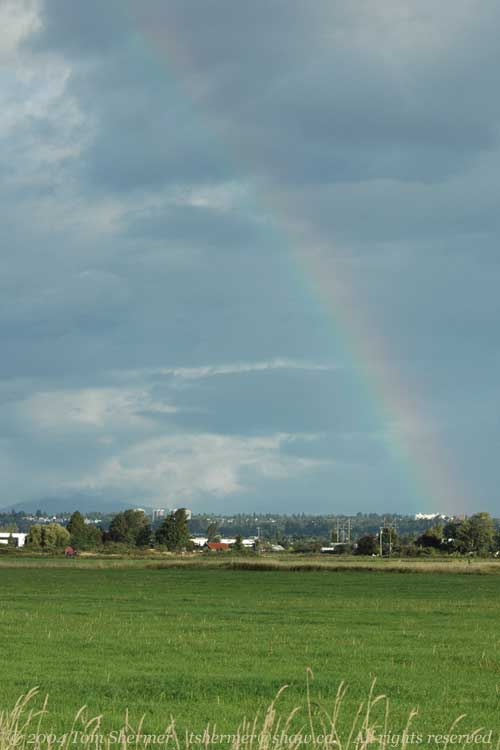 |
|
Rainbows are the result
of some interesting physics. Basically, the effect is due to light
hitting the front of a rain droplet, going into it, bouncing off
the back edge of the droplet, and coming back out the front. Each
droplet acts as both a prism (bending the light as it enters or
leaves the droplet) and a mirror (bouncing the light back towards
the side it came in on). The curved shape of a droplet (which,
by the way, is a very good approximation of a sphere, not the
"teardrop" shape most people imagine) ensures that the
entrance and exit bends (refractions) don't cancel each other
out, as they do in a glass-covered mirror.
There's more to the
explanation than that, but I don't want to overwhelm anyone with
technical details. Besides which, there are birds to get to.
I arrived at Iona and
headed for the inner ponds. There were many shorebirds there,
and I quickly found all three common peeps. Here is a photo with
a Semipalmated Sandpiper on the left and a Least Sandpiper on
the right.
|
|
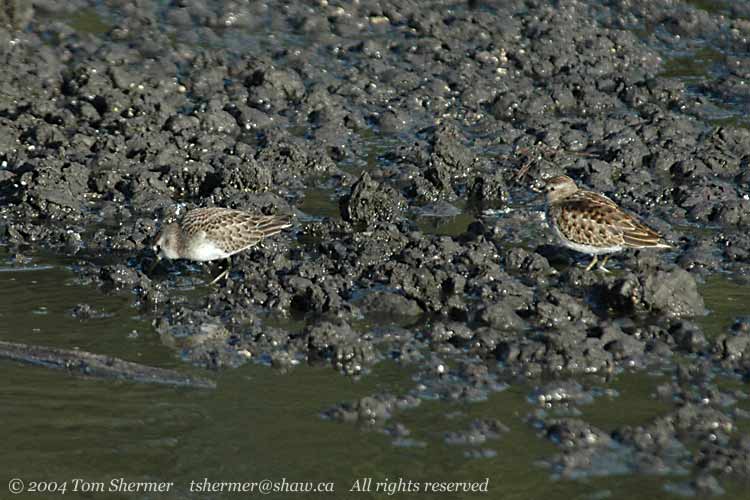 |
|
The Semipalmated has
a much greyer color overall and black legs where the Least has
yellow. That last bit may be a little hard to tell from the photo
here, but in the full-resolution one, the leg colors are a bit
more obvious.
The third common peep
is the Western Sandpiper. Here's one of these guys. Like the Semipalmated,
he's got black legs, but like the Least, he's got that red-brown
color. The bill shape and white breast are different from the
others, too. In fact, the clean breast and red color means that
this one's a juvenile. The other peeps were likely juveniles,
too.
|
|
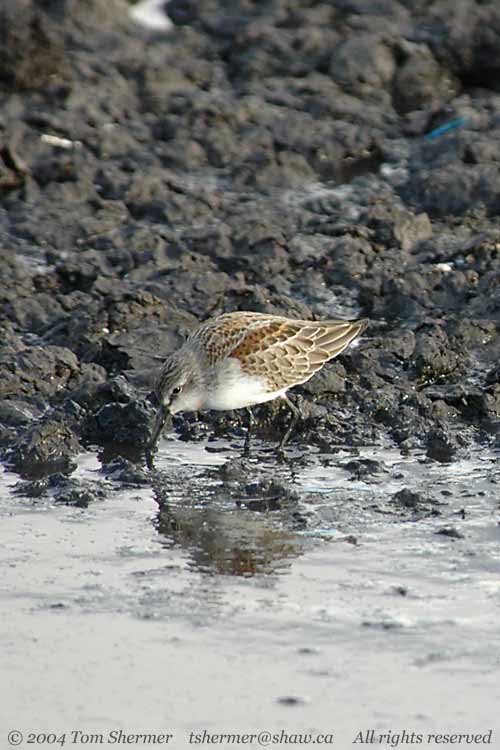 |
|
Also in the area were
plenty of Pectoral Sandpipers. Pectorals look like a big version
of the Least Sandpiper. It's sometimes difficult in photos to
tell which one you've got, unless there is some clue to the size
of the bird. On the other hand, sometimes it's easy to tell--the
Pectoral Sandpiper has an orange bill, where the Last Sandpiper
has a black one. In this photo (as is often the case in life),
both Pectorals have their bill covered in mud, making a color
determination difficult.
|
|
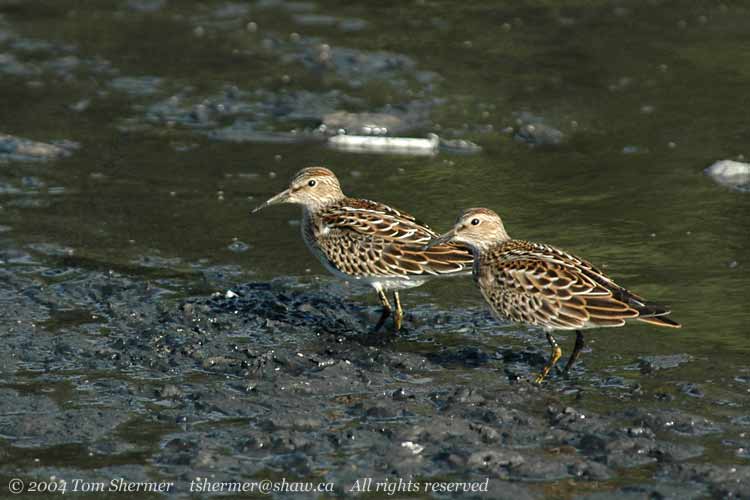 |
| Also hanging
around at the inner ponds were some Long-billed Dowitchers. This
is an adult Dowitcher, in nonbreeding plumage. By itself, it's hard
to tell whether this is a Long-billed or a Short-billed Dowitcher.
There were some juvenile dowitchers around, though, and they were
clearly Long-billed. So I'm assuming that these are Long-billed
as well. If it was a mixed flock, I may well be wrong. |
|
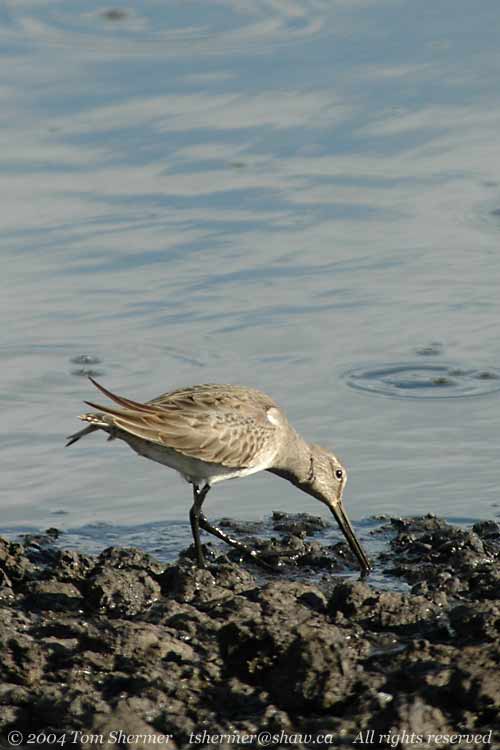 |
| Here's a
good photo for size comparisons of these beasties. From largest
to smallest, this shows a Long-billed Dowitcher, A Pectoral Sandpiper,
and a Least Sandpiper. The other peeps (Westerns and Semipalmateds)
are about the same size as the Least. |
|
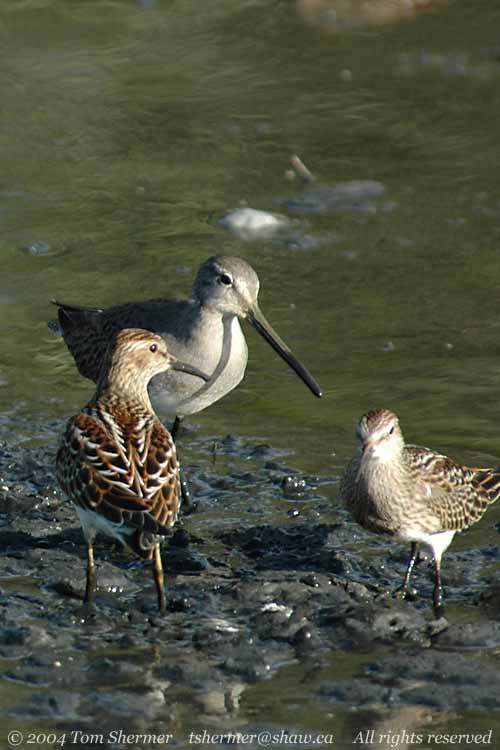 |
| As a birder
and a wildlife photographer, I have to be aware of my impact on
the critters that I'm out in the field with. Birds are known to
be quite sensitive to the presence of humans around them. Some birds
may ignore your presence, but others will be paying attention to
everything you do. That is why, for instance, it is considered bad
form to tilt your head too far to the side when you're out birding...the
poor blighters might fall over. |
|
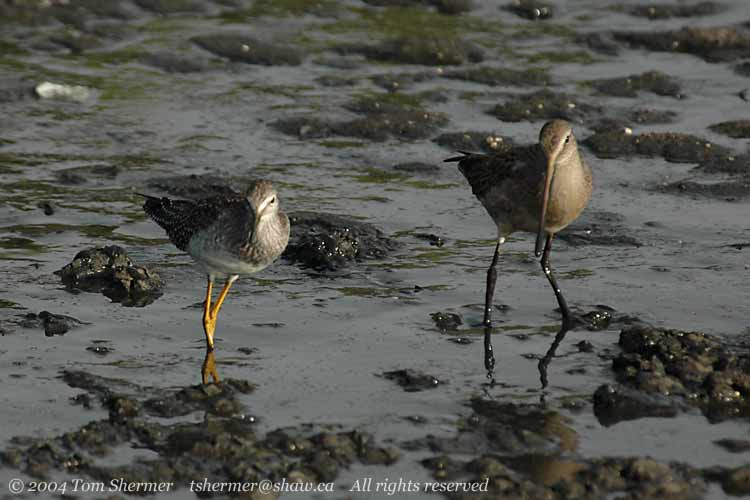 |
| Well, I
had gotten a good variety of shorebirds at the inner ponds, and
I headed on out to the public part of the park. There I decided
to head out the south jetty. As you can perhaps see here, the jetty
is about 20-25 meters across, with a big cement-covered pipe down
the north side of it. Here, all of the people are on the pipe. To
the south (left) of the pipe is a gravel road. The jetty is about
4 kilometers long; and for the first time ever, I walked down to
the end of it. I don't know how far the guy in the red jacket went. |
|
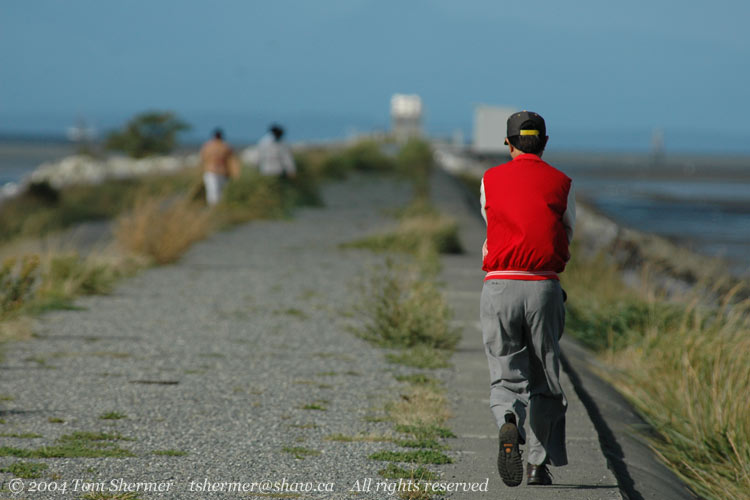 |
|
A little ways along
the jetty, I found an old upturned tree stump with a Savannah
Sparrow on it. Here's the sparrow in the process of taking off.
|
|
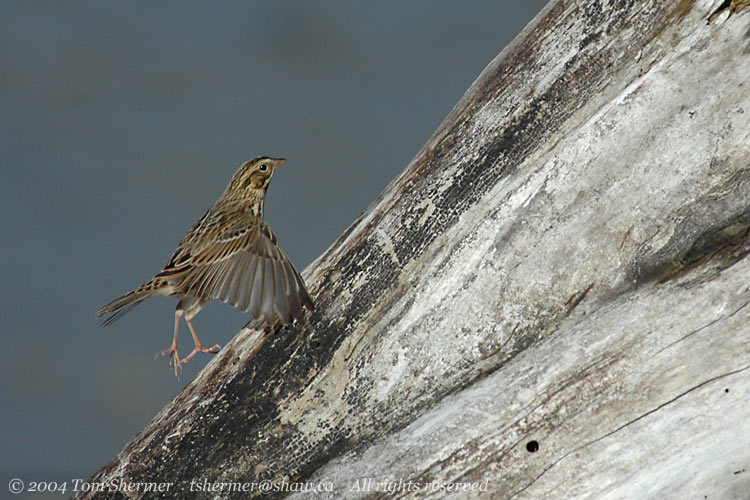 |
|
All he did was fly
up to the top of it, though.
|
|
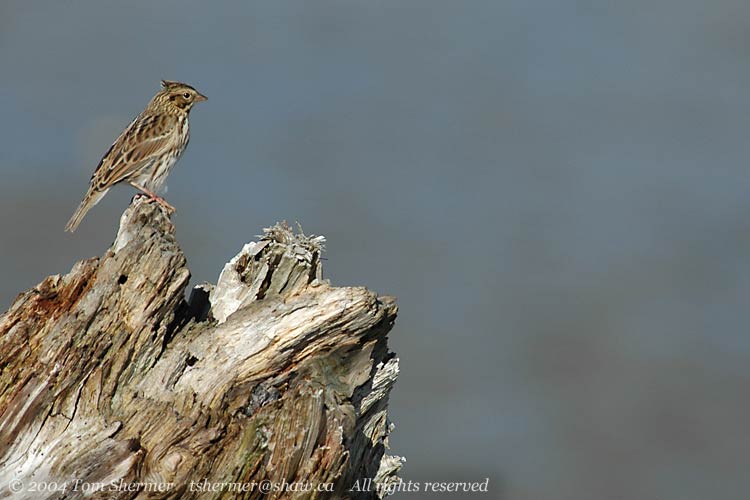 |
|
He didn't stay long
before flitting off to the pilings on the side of the jetty.
North of the jetty,
in the shallow bay, there was a neat-looking Great Blue Heron.
He's all dark and windwept. The different colors--black, white,
rust--were nice on a bird that's often mainly a dull gray. I think
this is a juvenile, and that's part of the reason for the interesting
plumage.
|
|
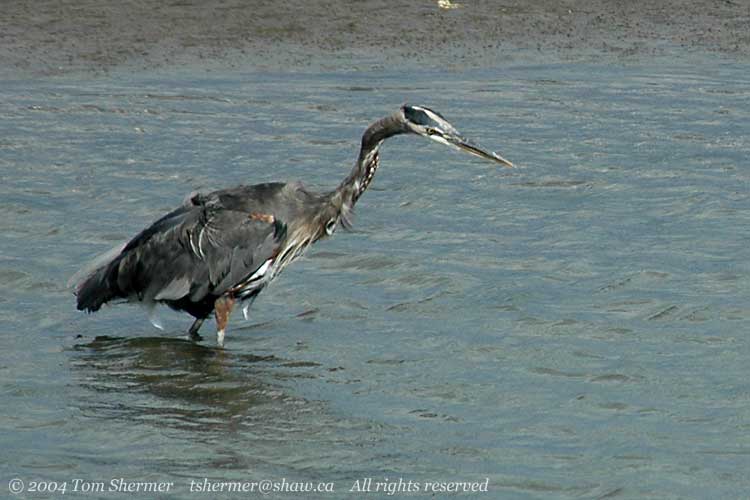 |
|
There were also a few
gulls north of the jetty. Here's a Ring-billed Gull.
|
|
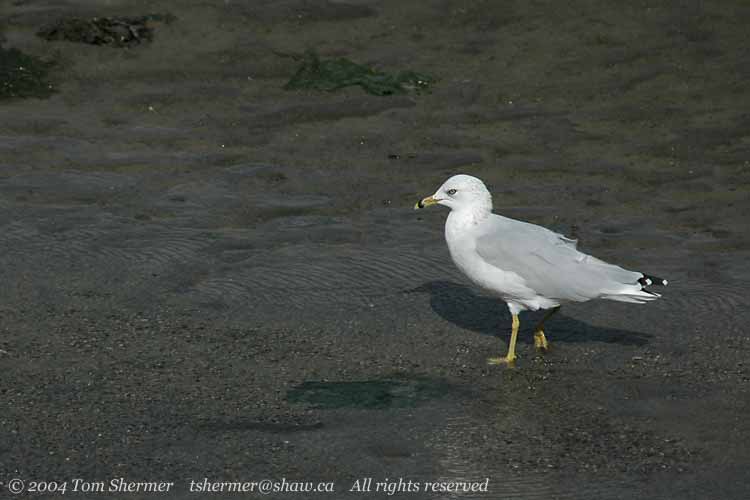 |
| The following
gull, who is looking quite geeky, is hard to classify. He's possibly
a Thayer's Gull, and possibly something else. Check out just how
different this gull is from the previous one, though...and to think,
I used to just class them all as essentially the same bird. |
|
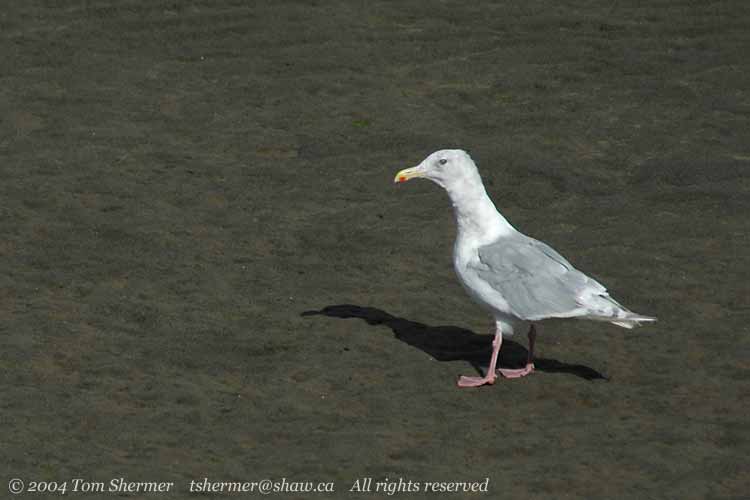 |
|
About three or three-and-a-half
kilometers out the jetty, I saw some small shorebirds on a dry
part of the bay just north of the jetty. I climbed down the rock
pilings on the side of the jetty to get onto a nearby sand bar.
As I was going down, I noticed a shiny thing out on the sand.
|
|
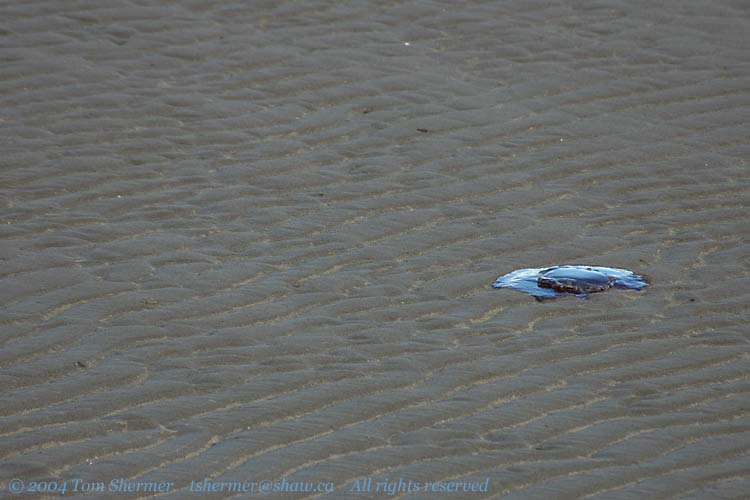 |
|
Closer inspection revealed
that it was a jellyfish. Well, that was cool!
|
|
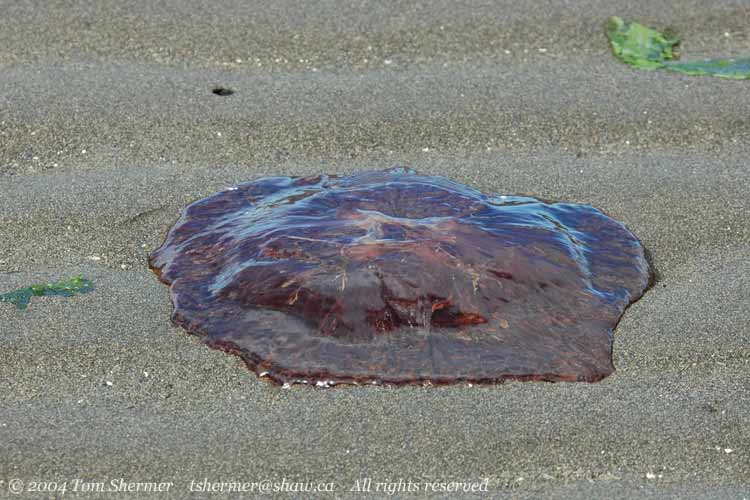 |
|
Obviously, this jelly
had been caught too far in the bay when the tide went out, and
it got beached. I have no idea if it was alive or dead. Would
it just go on with life when the tide came in again?
These jellies are
actually fairly nasty things to encounter; their sting is quite
bad. In my scuba training, they said that if you've seen one of
these guys (the local red jellyfish) while underwater, then when
you get out, both you and your partner must check each other all
over for jellyfish tentacles stuck to your diving suit. They trail
long sometimes invisible tentacles in the water, and you can swim
through them without noticing (because you have your suit on--if
you didn't, you'd notice!).. We also had to carry vinegar (which
neutralizes the jellyfish's sting) in our diving kits, because
of these guys. At Boundary Bay, I've seen posters warning people
not to touch any beached jellyfish.
There are other kinds
of jellyfish that we get out here, such as Moon Jellyfish, but
they don't pose the hazard that these red guys do.
So I was psyched about
finding a jellyfish. I noticed a few circular holes in the sand,
and wondered what causes them. Probably some critter or 'nuther.
Maybe someone out there will enlighten me.
|
|
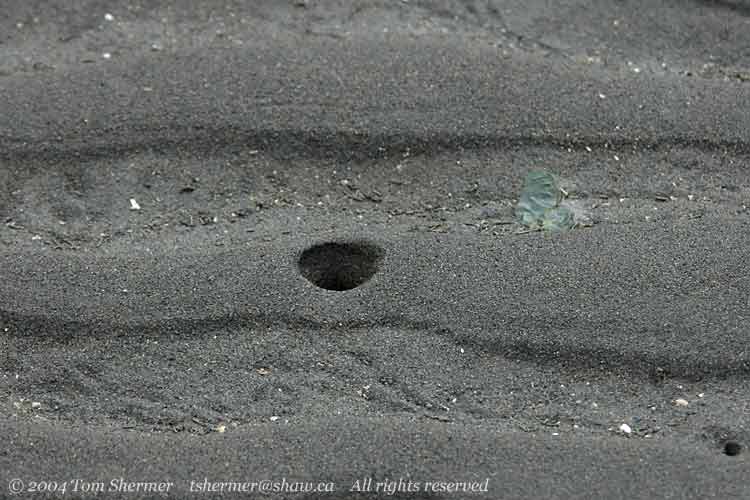 |
|
In the excitement of
finding the jelly, I didn't forget about why I had come down off
the pipe in the first place--there were some whitish, small shorebirds
here.
|
|
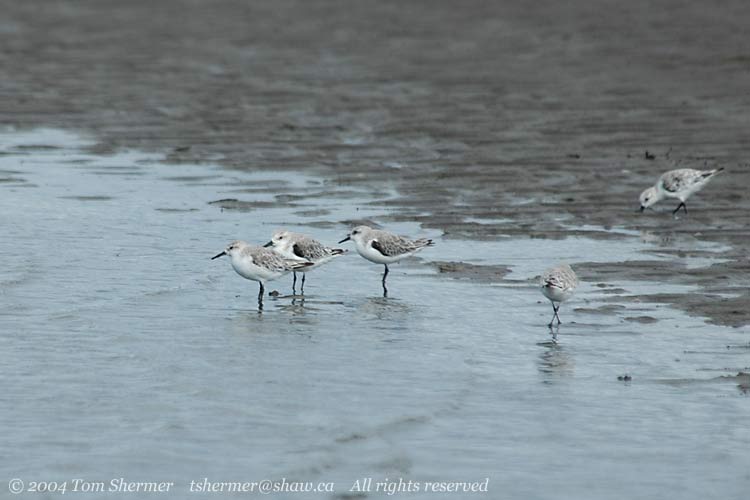 |
|
These are Sanderlings,
and that's a lifer for me. Sanderlings are just a little bigger
than the Least Sandpipers and other peeps. Sanderlings will chase
waves on a beach, going in and out with each wave. I've yet to
see this behavior myself; it was not a day for waves. The tide
was just slowly creeping in.
After taking a bunch
of Sanderling photos, I climbed back up onto the jetty pipe. On
the other (south) side of the jetty, there was a structure made
of some piles with tilted members and a cross member. On top of
this structure were a bunch of Double-crested Cormorants.
|
|
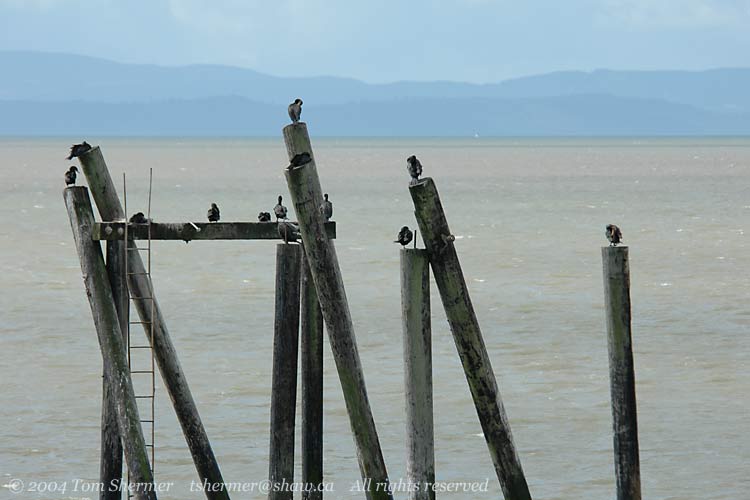 |
| As I approached
the tip of the jetty, one of the Coast Guard hovercraft zipped by.
These are big, noisy vessels. I used to see them a few times a year
on the Fraser River up by where I live, but I haven't seen them
there in several years. I don't know if that's just because I haven't
been there when the hovercraft has been by, or if they've changed
policy and don't come up the river any more. |
|
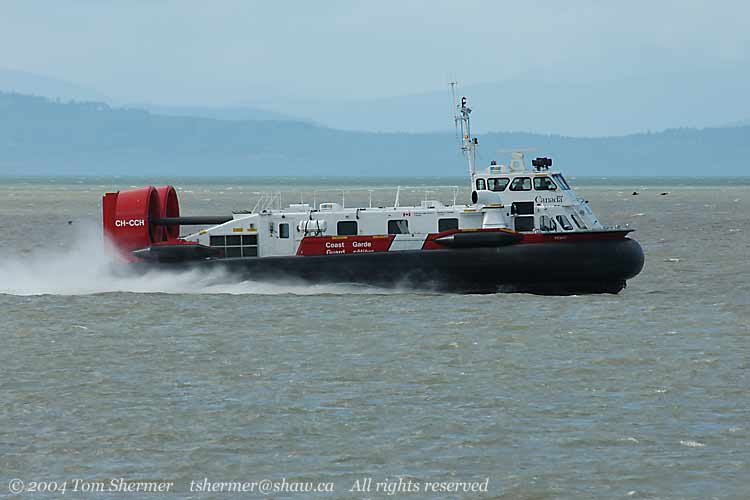 |
| Off the
tip, there's a tower that holds a light to warn ships off the jetty.
There were a bunch of Double-crested cormorants on that tower, too.
It seems that they were covering anything that stuck up out of the
water far enough. |
|
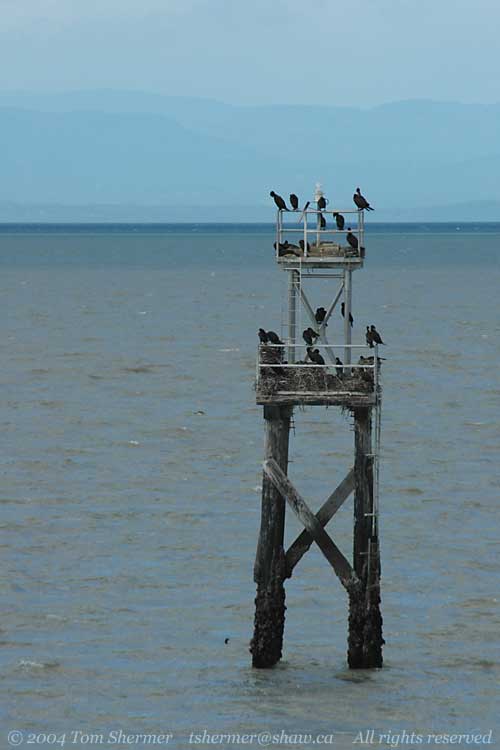 |
| There's
a little observation platform at the end of the jetty. From there,
I could see a small group of ducks near the rocks below. These ducks
were Surf Scoters, and they were another lifer. Here's a few of
them...females and/or juveniles...with two talking to one another. |
|
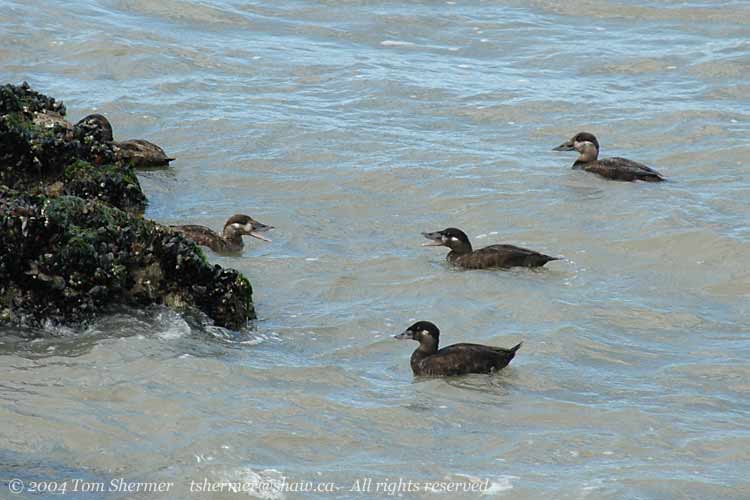 |
| The male
Surf Scoters are even funkier, with their big honkin' bill mainly
orange, with a black spot in a white spot on it. The eyes also appear
white.They've got a white spot on the forehead and another white
spot on the lower back of the head. A very colorful bird, indeed! |
|
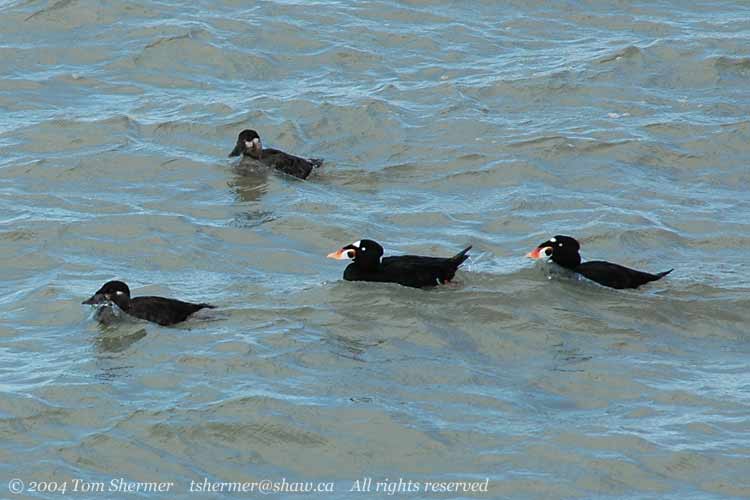 |
|
Well, the scoters made
my day and I walked the 4km back down the jetty a happy man. I
didn't encounter too much different wildlife on my way back, and
I was pretty bagged when I got to my car.
On my way home, I stopped
at a store in Queensborough, just across the river from where
I live. There I noticed a beautiful sky--there was a softly-color-modulating
layer of clouds in the background, with a few backlit clouds in
front. I snapped a few photos of the effect before calling it
a day.
|
|
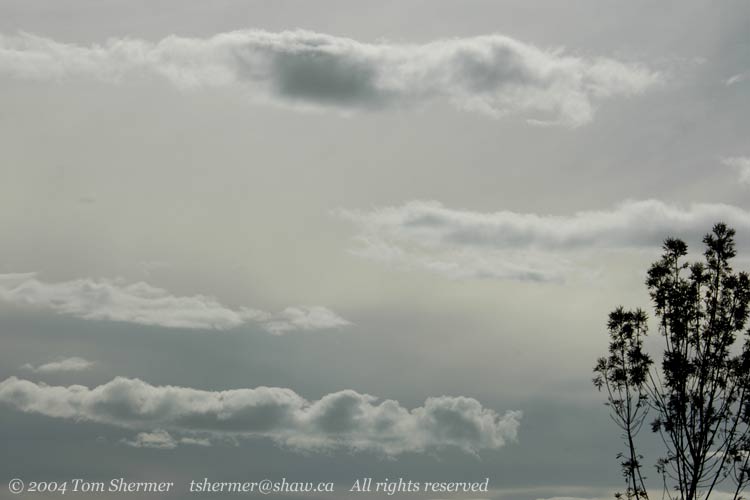 |
|
Ya gotta love those
backlit clouds--they can turn even a mainly grey sky into something
interesting.
Your funky-duck finder,
Tom
|
|